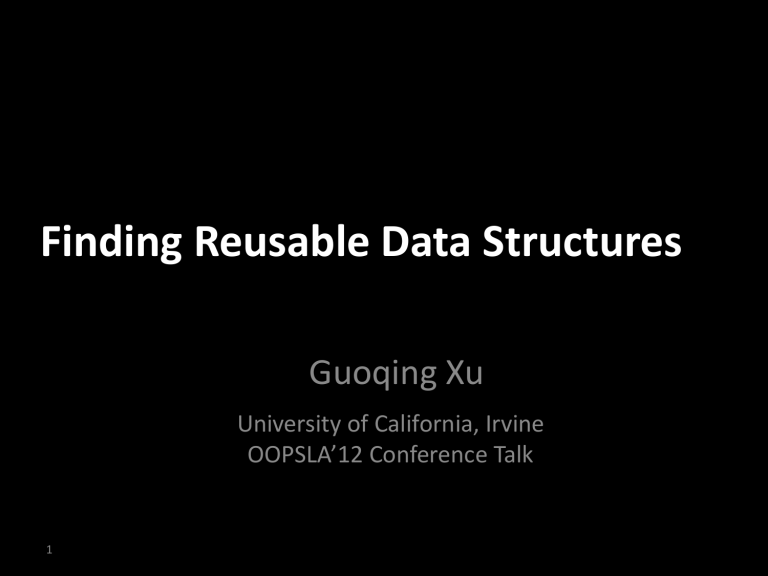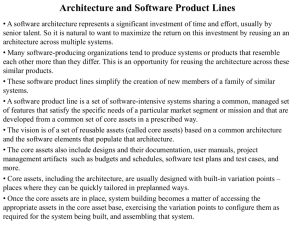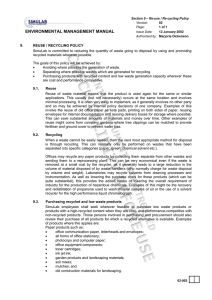Finding Reusable Data Structures Guoqing Xu University of California, Irvine OOPSLA’12 Conference Talk

1
Finding Reusable Data Structures
Guoqing Xu
University of California, Irvine
OOPSLA’12 Conference Talk
2
Excessive Object Creation
• A significant source of run-time bloat
– Developers are encouraged to create objects
• Costs of using objects
– Creating, initializing, and destroying them all takes time and space
• Example
– Using objects to represent data items in a Big Data application can drive the GC time up to 47% of the total running time
• The effort is unnecessary if identical objects are frequently created, initialized, and destroyed
Reusing Data Structures
• A common practice
– 4/18 best practices are instructions to avoid repeated creation of identical objects ( WebSphere
Application Server best practices white paper )
– Reusing object instances in the Big Data application can significantly reduce the GC effort
• Our focus: a dynamic analysis to find and report reusable data structures
4
Reusability Levels
• Reuse object instances ( I )
– Object lifetimes are disjoint
• Reuse data structure shapes ( S )
– Reference relationships are identical
• Reuse data content ( D )
– Data values contained in the fields are identical
• Focus on allocation sites
– Finding reuse opportunities among the data structures created by the same allocation site
Optimization Example
for(int i = 0; i < N; i++){
A a = new A(); a.f =1 ; B b = new B(); b.g = 1; a.link = b;
//use a
}
Reuse Instances for(int i = 0; i < N; i++){
A a = getAInstance();
B b = getBInstance(); a.f =1 ; b.g = 1; a.link = b;
//use a
} static A instance = new A();
A getAInstance (){ return instance;
}
B getBInstance (){ … }
5
Reuse Shapes Reuse Data for(int i = 0; i < N; i++){
A a = getAInstance(); a.f =1 ; a.link.g = 1;
//use a
} for(int i = 0; i < N; i++){
A a = getAInstance();
//use a
}
} static A instance = new A();
A getAInstance (){ if(a.link == null) a.link = new B(); return instance;
} static A instance = new A();
A getAInstance (){ if(a.link == null){ a.link = new B(); a.f = 1; a.link.g = 1;
} return instance;
Approximating Instance Reusability
• Goal: compute a measurement IR(a) for each allocation site a , indicating how likely a creates disjoint objects
• At each GC, compute a DL ratio
– # Dead Objs / # Live Objs
• IR(a) = AVG
GC
(# Dead Objs / # Live Objs)
• The large number of GC runs help reduce the imprecision
Computing IR
• Counting incoming references for each object
• Add an object to a dead object queue whenever its rc becomes 0
• Add a pass at the end of each
GC to traverse the objects from those (roots) in the queue
• Identify a dead data structure
Approximating Shape Reusability
• Goal: compute a measurement allocation site
SR(a) for each a that indicates how likely a creates data structures with the same shape
•
• Interested only in dead data structures
• Encoding a shape into a (probabilistically) unique value
SR(a) is determined by comparing the encoded shapes for all dead data structures created by a
Encoding Shapes
• Base algorithm: balanced parenthesis (BP) algorithm
• Modified BP
– Break cycles
– Turn the vector into an integer value
– s(n) = ID n
+
∑ child i
– Shapes n
• SR(n)
[ s(n) % 7 ]++
= max( f i
* s(i)
Shapes n
)
/sum( Shapes n
) f i
Encoding Data
• Encode values contained in primitive-typed fields of a data structure into a
(probabilistically) unique value
• An algorithm similar to the shape encoding is used
Implementation
• JikesRVM 3.1.0
– Both baseline and optimizing compilers are modified
– Add a one-word header, shared by alloc ID and reference count
• Average overhead (across 14 programs) on
FastAdativeImmix
– 10.8% running time overhead
– 30.3% space overhead
Six Case Studies
• chart: 24.2% running time reduction and
15.3% GC time reduction by reusing XYSeries[]
• 1usearch: 9% GC run reduction and 4.7% peak memory reduction by reusing
QueryParser
• xalan: 22% GC time reduction by reusing
XPathParser
• SPECJbb2000: 4.7% throughput improvement after reusing the *Transaction data structures
Conclusions
• A dynamic technique to approximate reusability for data structures to help developers find optimization opportunities
– Define three reusability levels
– Develop three approximations to compute reusability
• Implemented in JikesRVM and evaluated on
14 large programs
– Useful in exposing reuse opportunities
Thank You
Q/A
False Positives
• Among the 20 alloc sites we have inspected, those for which no optimization opportunities could be found are considered as false positives chart bloat luindex lusearch xalan jbb
6
0
4
5
I
0
8
4
0
4
S
5
0
6
2
0
1
D
4
0
2
• All false positives come from the (imprecise) approximation of object lifetimes




